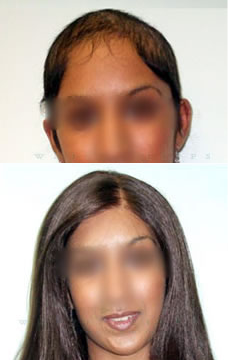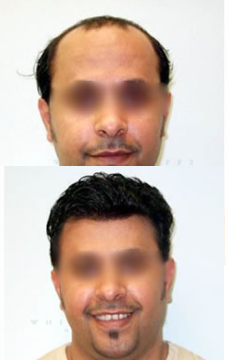

Contents of this guide
What is Hair Replacement
Hair replacement refers to various techniques and products used to restore hair for individuals experiencing hair loss. These methods can be either non-surgical, such as wigs, toupees, and hairpieces, or surgical, such as hair transplants. The goal is to achieve a natural look and feel, enhancing the individual’s appearance and confidence. Hair replacement solutions are customized to meet the unique needs of each person, taking into account the extent of hair loss, hair type, and lifestyle.
Hair Replacement Process
- Consultation: Initial consultation with a hair replacement specialist to assess hair loss and determine the best solution.
- Custom Fitting: Measurements and molds are taken to ensure a custom fit for hair systems.
- Selection of Materials: Choice of lace type, hair type, and other materials based on individual needs and preferences.
- Application: Application of the hair replacement system, which can be non-surgical (wigs, toupees) or surgical (hair transplants).
- Maintenance: Regular maintenance and care instructions are provided to ensure the longevity and natural appearance of the hair system.
Types of Laces
Swiss Lace
- Description: Known for its fine texture and high breathability, making it virtually undetectable when worn.
- Advantages: Natural look, lightweight, breathable.
- Disadvantages: Less durable, requires delicate handling. With 100% density, lasts approximately 2 to 3 months due to single knots.
- Best For: Individuals seeking a natural hairline and comfortable wear.
French Lace
- Description: Slightly thicker than Swiss lace, French lace offers a good balance between natural appearance and durability.
- Advantages: Natural look, durable, easier to handle.
- Disadvantages: Slightly less breathable than Swiss lace.
- Best For: Those looking for a long-lasting hairpiece with a natural look. Averages 3 to 6 months with careful usage.
Monofilament
- Description: Made from a fine mesh, monofilament lace provides a realistic scalp appearance, especially useful for those with sensitive scalps.
- Advantages: Realistic scalp appearance, strong, good for sensitive skin.
- Disadvantages: Can be less breathable.
- Best For: Individuals with sensitive skin and those needing a realistic scalp appearance. With 100% natural hair and double knots, lasts 6 months to 1 year.
Skin Base System
- Description: Does not breathe but can look very natural.
- Advantages: Natural appearance.
- Disadvantages: Lack of breathability.
- Best For: Individuals seeking a highly natural look.
Injected Lace Systems
- Description: A budget-friendly option that offers a natural appearance.
- Advantages: Affordable, natural look.
- Disadvantages: Less durable.
- Best For: Individuals seeking a cost-effective hair replacement solution.
Lace Front
- Description: Combines the advantages of lace and poly materials, with lace at the front for a natural hairline and poly at the back for durability.
- Advantages: Natural front hairline, durable, versatile.
- Disadvantages: Slightly more complex to apply.
- Best For: People looking for a durable hairpiece with a natural front hairline.
Types of Hair
Human Hair
- Description: Offers the most natural look and feel, as it can be styled and colored just like your own hair.
- Advantages: Natural appearance, versatile, durable.
- Disadvantages: Higher cost, requires maintenance.
- Best For: Those seeking the most authentic appearance and versatility.
Synthetic Hair
- Description: Made from various synthetic fibers, these hairpieces are more affordable but less natural-looking than human hair.
- Advantages: Cost-effective, low maintenance, pre-styled.
- Disadvantages: Less natural look, limited styling options.
- Best For: Individuals looking for a cost-effective solution with low maintenance.
Heat-Friendly Synthetic Hair
- Description: A type of synthetic hair that can withstand heat styling, offering more versatility than standard synthetic hair.
- Advantages: Can be heat-styled, more natural look than regular synthetic hair.
- Disadvantages: Can still look less natural than human hair, moderate durability.
- Best For: Those wanting the styling versatility of human hair at a lower cost.
Hair Replacement Methods
Non-Surgical Hair Systems
- Description: Includes wigs, toupees, and hairpieces that can be worn daily or semi-permanently. Non-surgical hair replacement is popular for its immediate results and customization options.
- Advantages: Immediate results, non-invasive, customizable.
- Disadvantages: Requires regular maintenance, potential for discomfort if not fitted properly.
- Precautions: Ensure proper fit and regular cleaning.
- Side Effects: Rare, but possible skin irritation.
- Best For: Men, women, and children seeking an immediate and non-invasive solution.
Hair Transplant Surgery
- Description: Involves transplanting hair follicles from one part of the scalp to another, offering a permanent solution. Hair transplants are a favored method of hair replacement for men and women who seek long-term results.
- Advantages: Permanent results, uses your own hair, natural look.
- Disadvantages: High cost, surgical risks, recovery time.
- Precautions: Choose a qualified surgeon, follow post-surgery care instructions.
- Side Effects: Scarring, infection, swelling, temporary shedding.
- Best For: Men and women seeking a permanent solution to hair loss.
Scalp Micropigmentation
- Description: A non-surgical procedure that uses micro-needles to deposit pigment into the scalp, creating the appearance of hair follicles.
- Advantages: Immediate results, non-invasive, low maintenance.
- Disadvantages: Not actual hair, limited to short hair or shaved look.
- Precautions: Choose a skilled practitioner, follow aftercare instructions.
- Side Effects: Minor swelling, redness, potential allergic reaction.
- Best For: Individuals (men and women) looking for a low-maintenance solution to thinning hair or bald spots.
Cost and Standards
The cost of hair replacement varies based on the method, type of hair, and quality of lace used. Here’s a breakdown in both INR and USD:
Cost of different hair replacement methods
Synthetic Hair Systems
- India: ₹16,000 – ₹48,000 ($200 – $600)
- USA: $300 – $700
- UK: £250 – £600
Heat-Friendly Synthetic Systems
- India: ₹24,000 – ₹64,000 ($300 – $800)
- USA: $400 – $900
- UK: £300 – £700
Injected Lace Systems
- India: ₹24,000 – ₹64,000 ($300 – $800)
- USA: $400 – $900
- UK: £300 – £700
Human Hair Systems
- India: ₹56,000 – ₹1,60,000 ($700 – $2000)
- USA: $1000 – $2500
- UK: £700 – £2000
Scalp Micropigmentation
- India: ₹1,20,000 – ₹3,20,000 ($1500 – $4000)
- USA: $2000 – $5000
- UK: £1500 – £3500
Hair Transplants
- India: ₹3,20,000 – ₹12,00,000 ($4000 – $15000)
- USA: $6000 – $15000
- UK: £4000 – £12000
Standards and Considerations
When choosing a hair replacement solution, consider the following standards:
- Natural Appearance: The lace and hair type should blend seamlessly with your natural hair and skin tone.
- Durability: Ensure the hairpiece or method chosen can withstand your lifestyle and activities.
- Comfort: The lace and attachment method should be comfortable for long-term wear.
- Maintenance: Consider the time and effort required to maintain the hairpiece or results.
- Cost: Balance your budget with the quality and longevity of the solution.
Hair Replacement for Different Needs
Alopecia Treatment: Individuals with alopecia can explore hair replacement options to manage and reduce visible hair loss, promoting a sense of normalcy and boosting self-esteem.
Hair Replacement for Men: Men may choose hair replacement solutions when experiencing thinning or balding due to genetics, aging, or medical conditions. These options help restore confidence and provide a natural look.
Hair Replacement for Women: Women might seek hair replacement to address hair loss from hormonal changes, stress, or medical treatments. Hair replacement offers a way to regain volume and a natural appearance.
Hair Replacement for Children: Children experiencing hair loss from medical conditions or treatments can benefit from gentle and effective hair replacement options, helping them feel more comfortable and confident.
Hair Replacement for Cancer Patients: Cancer patients undergoing chemotherapy often face significant hair loss. Hair replacement systems and wigs offer a way to maintain a sense of normalcy and confidence during treatment.
Conclusion
Hair replacement offers a variety of options to suit different needs and preferences. By understanding the types of laces, hair, methods, and associated costs, you can make an informed decision that best suits your lifestyle and budget. Whether you choose a non-surgical hair system, a hair transplant, or scalp micropigmentation, the right choice can restore your confidence and enhance your appearance.